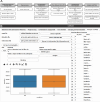ClearFinder: a Python GUI for annotating cells in cleared mouse brain
- PMID: 39838291
- PMCID: PMC11753021
- DOI: 10.1186/s12859-025-06039-x
ClearFinder: a Python GUI for annotating cells in cleared mouse brain
Abstract
Background: Tissue clearing combined with light-sheet microscopy is gaining popularity among neuroscientists interested in unbiased assessment of their samples in 3D volume. However, the analysis of such data remains a challenge. ClearMap and CellFinder are tools for analyzing neuronal activity maps in an intact volume of cleared mouse brains. However, these tools lack a user interface, restricting accessibility primarily to scientists proficient in advanced Python programming. The application presented here aims to bridge this gap and make data analysis accessible to a wider scientific community.
Results: We developed an easy-to-adopt graphical user interface for cell quantification and group analysis of whole cleared adult mouse brains. Fundamental statistical analysis, such as PCA and box plots, and additional visualization features allow for quick data evaluation and quality checks. Furthermore, we present a use case of ClearFinder GUI for cross-analyzing the same samples with two cell counting tools, highlighting the discrepancies in cell detection efficiency between them.
Conclusions: Our easily accessible tool allows more researchers to implement the methodology, troubleshoot arising issues, and develop quality checks, benchmarking, and standardized analysis pipelines for cell detection and region annotation in whole volumes of cleared brains.
Keywords: 3D volumetric imaging; Atlas alignment; Cell count; Tissue clearing.
© 2025. The Author(s).
Conflict of interest statement
Declarations. Ethics approval and consent to participate: All experiments were performed according to the European Community's Council Directive of 22 September 2010 (2010/63EU) and approved by the respective agency of the State Rhineland-Palatinate (Landesuntersuchungsamt, permit number G-17-1-021). Consent for publication: Not applicable. Competing interests: The authors declare that they have no competing interests.
Figures




References
-
- Ueda HR, Erturk A, Chung K, Gradinaru V, Chedotal A, Tomancak P, et al. Tissue clearing and its applications in neuroscience. Nat Rev Neurosci. 2020;21:61–79. 10.1038/s41583-019-0250-1. - PubMed
-
- Kirst C, Skriabine S, Vieites-Prado A, Topilko T, Bertin P, Gerschenfeld G, et al. Mapping the fine-scale organization and plasticity of the brain vasculature. Cell. 2020;180:780-795.e25. 10.1016/j.cell.2020.01.028. - PubMed
MeSH terms
Grants and funding
LinkOut - more resources
Full Text Sources
Miscellaneous

